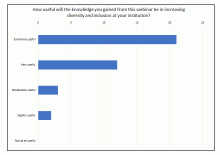
Recently my office partnered with the Association of American Medical Colleges (AAMC) to host a webinar on organizational approaches to effect culture change. As you’ve read in my past communications, and described in a previous webinar, NIH developed the NIH Scientific Workforce Diversity Toolkit, a free, downloadable interactive resource institutions can use to achieve inclusive excellence – establishing and maintaining scientific environments that can cultivate and benefit from a full range of talent.
But having these tools, and using them, isn’t sufficient to instigate the culture change that is needed for creating such environments. Putting the tools to use in the complex environment of academic science requires institutional engagement and accountability, which is driven by concrete steps to understand individual institutional cultures as each one is unique.
NIH’s current approach and activities to achieve inclusive excellence in the scientific workforce center on monitoring, tracking, and implementing equity measures. We are pursuing this goal through use of approaches in the SWD Toolkit, such as implicit-bias education, recruiting diverse talent, and proactive outreach to potential candidates – and pairing the tools with oversight through the NIH Equity Committee. As another vehicle for institutional change, we have teamed with the NIH intramural research program (IRP) to launch the Distinguished Scholars Program (DSP) to increase faculty diversity through a cohort-hiring model and professional-development programming that aims to facilitate institutional culture change within the NIH IRP.
NIH is currently exploring an opportunity to create an extramural version of the DSP, and we want to hear from you. With the NIH Common Fund, we have issued a request for information (RFI) soliciting background information and guidance on institutional and/or programmatic approaches to advance inclusive excellence through institutional change. Our goal is to employ a cohort model at the faculty level as a catalyst for institutions to create a route of entry and advancement for talent from diverse backgrounds, including scholars from groups underrepresented in biomedical research. The RFI is open until June 14, 2019, and we’d love to hear from you.
In this webinar, we also heard from David Acosta, AAMC’s Chief Diversity and Inclusion Officer, who described approaches to assess institutional culture and climate, including use of the AAMC Foundational Principles of Inclusion Excellence survey (FPIE survey). Institutions can use this resource to assess their own institutional culture and climate and to provide them with a roadmap for achieving inclusion excellence in learning and research environments. The FPIE survey provides a set of nine benchmarks of inclusion excellence, an institutional assessment survey, scorecard, and a database of identified effective practices for each benchmark – accompanied by a set of resources that can guide development of strategic action plans (including target goals and metrics) to achieve these benchmarks. The webinar discussed practical application of the survey at institutions. For more information about the survey, please contact either Dr. Acosta or Laura Castillo Page.
We were pleased to have a lively discussion with webinar attendees from institutions across the country, who shared with us some of their experiences. Although we did not capture information from every attendee and our sample size is relatively small, below are some of the general things we learned from a survey administered before and after the webinar.
1. Webinar attendees reported many barriers to achieving diversity and inclusion. Leading the list was an insufficient number of applicants from diverse backgrounds for faculty positions, but other barriers include resistance from leadership and search committees to both attract and hire diverse talent. Insufficient resources and an unwelcoming climate were other responses. Primary approaches to measuring equity included administering a climate survey and collecting demographic data.
2. Before attending the webinar, many attendees reported not having sufficient knowledge or tools to correct identified inequities at their own institution (Fig. 1).

3. After attending the webinar, several attendees reported their intent to address seek leadership support/endorsement and to establish an equity committee to promote inclusive excellence at their institution. “Requesting faculty to participate in implicit-bias education” was the top answer to our pre-webinar survey question, “What measures do you use to ensure workforce equity at your institution?” Thus, we found it interesting that there was a statistically significant difference in attendees’ reported comfort in mitigating implicit bias in scientific searches and in academic environments (Fig. 2), a key component of NIH’s recommended approaches to promoting inclusive excellence (P=0.000232, t-test).

4. Finally, we learned that the vast majority of survey respondents reported that they gained useful information from the webinar to put to use at their own institution (Fig. 3). We hope you find this information useful and welcome your thoughts about using these approaches as well as what types of strategies are successful at your institution.


